by Eric Meier
When attempting to identify a wood sample, it’s important to keep in mind the limitations and obstacles that are present in our task. Before starting, please have a look at The Truth Behind Wood Identification to approach the task in a proper mindset; I consider the linked article to be required reading for all those visiting my site with the intent of identifying wood.
1. Confirm it is actually solid wood.
Before proceeding too much farther into the remaining steps, it’s first necessary to confirm that the material in question is actually a solid piece of wood, and not a man-made composite or piece of plastic made to imitate wood.
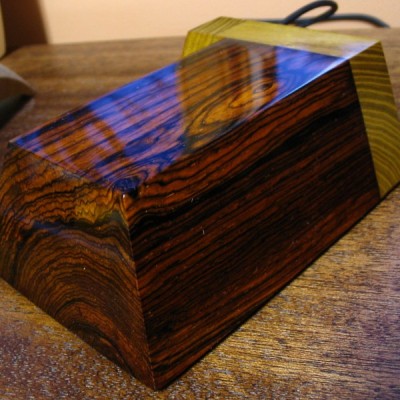
Can you see the end-grain?
Manufactured wood such as MDF, OSB, and particleboard all have a distinct look that is—in nearly all cases—easily distinguishable from the endgrain of real wood. Look for growth rings—formed by the yearly growth of a tree—which will be a dead-giveaway that the wood sample in question is a solid, genuine chunk of wood taken from a tree.
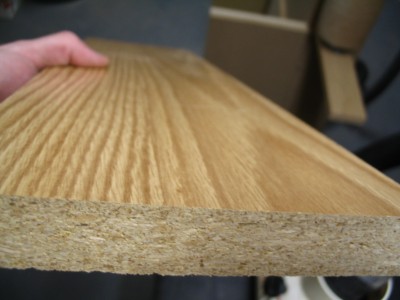
Is it veneered?
If you see a large panel that has a repeating grain pattern, it may be a veneer. In such cases, a very thin layer of real wood is peeled from a tree and attached to a substrate; sometimes the veneer can be one continuous repeating piece because it is rotary-sliced to shave off the veneer layer as the tree trunk is spun by machines. Assuming it is a real wood veneer with a distinct grain and texture—and not merely a piece of printed plastic—you may still be able to identify the outer veneer wood in question, but you should still realize that is it only a veneer and not a solid piece of wood.
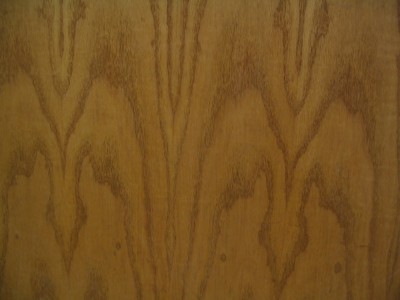
Is it painted or printed to look like wood?
Many times, especially on medium to large-sized flat panels for furniture, a piece of particleboard or MDF is either laminated with a piece of wood-colored plastic, or simply painted to look like wood grain. Many of today’s interior hardwood flooring planks are good examples of these pseudo-wood products: they are essentially a man-made material made of sawdust, glues, resins, and durable plastics.
2. Look at the color.
Some questions to immediately ask yourself:
Is the color of the wood natural, or is it stained?
If there is even a chance that the color isn’t natural, the odds are increased that the entire effort of identifying the wood will be in vain.
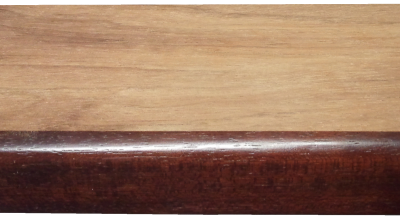
Is it weathered or have a patina?
Many woods, when left outside in the elements, tend to turn a bland gray color. Also, even interior wood also takes on a patina as it ages: some woods get darker, or redder, and some even get lighter or lose their color; but for the most part, wood tends to darken with age.
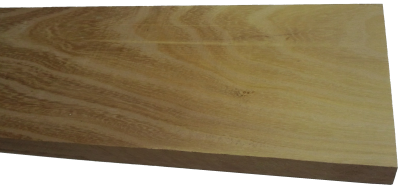
Is it possible to sand or plane the board to see the natural raw color of the wood?
The most predictable baseline to use when identifying wood is in a freshly sanded state. This eliminates the chances of a stain or natural aging skewing the color diagnosis of the wood.
3. Observe the wood grain.
If the wood is unfinished, then look at the texture of the grain. Ask yourself these questions:
Does the wood have an open, porous texture?
Most softwoods will be almost perfectly smooth with no grain indentations, while many common hardwoods have an open pore structure, such as oak or mahogany; though there are some hardwoods that are also smooth to the touch, such as maple.
Can you tell if the wood is quartersawn or plainsawn?
By observing the grain patterns, many times you can tell how the board was cut from the tree. Some wood species have dramatically different grain patterns from plainsawn to quartersawn surfaces. For instance, on their quartersawn surfaces, lacewood has large lace patterns, oak has flecks, and maple has the characteristic “butcher block” appearance.
Is there any figure or unusual characteristics, such as sapwood, curly or wild grain, burl/knots, etc.?
Some species of wood have figure that is much more common than in other species: for example, curly figure is fairly common in soft maple, and the curls are usually well-pronounced and close together. Yet when birch or cherry has a curly grain, it is more often much less pronounced, and the curls are spaced farther apart.
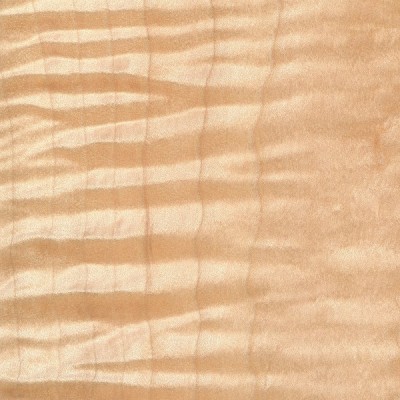
4. Consider the weight and hardness of the wood.
If it’s possible, pick the piece of wood up and get a sense of its weight, and compare it to other known wood species. Try gouging the edge with your fingernail to get a sense of its hardness. If you have a scale, you can take measurements of the length, width, and thickness of the wood, and combine them to find the density of the wood. This can be helpful to compare to other density readings found in the database. When examining the wood in question, compare it to other known wood species, and ask yourself these questions:
Is the wood dry?
Wood from freshly felled trees, or wood that has been stored in an extremely humid environment will have very high moisture contents. In some freshly sawn pieces, moisture could account for over half of the wood’s total weight! Likewise, wood that has been stored in extremely dry conditions of less than 25% relative humidity will most likely feel lighter than average.
How does the wood’s weight compare to other species?
Taking into account the size of the board, how does its weight compare to other benchmark woods? Is it heavier than oak? Is it lighter than pine? Look at the weight numbers for a few wood species that are close to yours, and get a ballpark estimate of its weight.
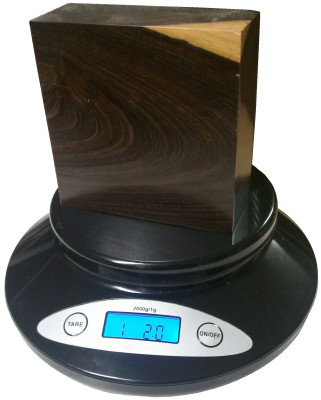
How hard is the wood?
Obviously softwoods will tend to be softer than hardwoods, but try to get a sense of how it compares to other known woods. Density and hardness are closely related, so if the wood is heavy, it will most likely be hard too. If the wood is a part of a finished item that you can’t adequately weigh, you might be able to test the hardness by gouging it in an inconspicuous area. Also, if it is used in a piece of furniture, such as a tabletop, a general idea of its hardness can be assessed by the number and depth of the gouges/dings in the piece given its age and use. A tabletop made of pine will have much deeper dents than a tabletop made of Oak. Additionally, you can always try the “fingernail test” as a rough hardness indicator: find a crisp edge of the wood, and with your fingernail try to push in as hard as you can and see if you’re able to make a dent in the wood.
5. Consider its history.
Many times we forget common sense and logic when attempting to identify wood. If you’ve got a piece of Amish furniture from Pennsylvania, chances are more likely that the wood will be made of something like black walnut or cherry, and not African wenge or jatoba. You might call it “wood profiling,” but sometimes it can pay to be a little prejudiced when it comes to wood identification. Some common-sense questions to ask yourself when trying to identify a piece of wood:
Where did it come from?
Knowing as much as you can about the source of the wood—even the smallest details—can be helpful. If the wood came from a wood pile or a lumber mill where all the pieces were from trees processed locally, then the potential species are immediately limited. If the wood came from a builder of antique furniture, or a boat-builder, or a trim carpenter: each of these occupations will tend to use certain species of woods much more often than others, making a logical guess much simpler.
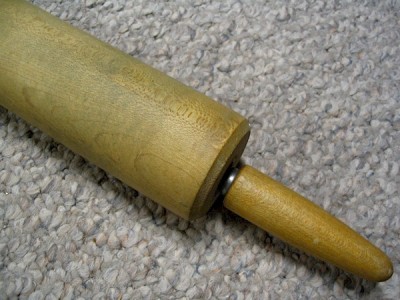
How old is it?
As with the wood’s source, its age will also help in identification purposes. Not only will it help to determine if the wood should have developed a natural patina, but it will also suggest certain species which were more prevalent at different times in history. For instance, many acoustic guitars made before the 1990s have featured Brazilian rosewood backs/sides, yet due to CITES restrictions placed upon that species, East Indian rosewood became a much more common species on newer guitars. (And this is a continuing shift as newer replacements are sought for rosewoods altogether.)
How large is the piece of wood?
Some species of trees are typically very small—some are even considered shrubs—while others get quite large. For instance, if you see a large panel or section of wood that’s entirely black, chances are it’s either painted, dyed, or stained: Gaboon ebony and related species are typically very small and very expensive.
What is the wood’s intended use?
Simply knowing what the wood was intended for—when considered in conjunction with where it came from and how old it is—can give you many clues to help identify it. In some applications, certain wood species are used much more frequently than others, so that you can make an educated guess as to the species of the wood based upon the application where it was used. For instance, in the United States: many older houses with solid hardwood floors have commonly used either red oak or hard maple; many antique furniture pieces have featured quartersawn white oak; many violins have spruce tops; many closet items used aromatic red cedar, and so forth. While it’s not a 100% guarantee, “profiling” the wood in question will help reduce the number of possible suspects, and aid in deducing the correct species.
6. Find the X-Factor.
Sometimes, after all the normal characteristics of a sample have been considered, the identity of the wood in question is still not apparent. In these instances—particularly in situations where a sample has been narrowed down to only a few possible remaining choices—it’s sometimes helpful to bring in specialized tests and other narrower means of identification.
The following techniques and recommendations don’t necessarily have a wide application in initially sorting out wood species and eliminating large swaths of wood species, but will most likely be of use only as a final step in special identification circumstances.
Odor
Believe it or not, freshly machined wood can have a very identifiable scent. When your eyes and hands can’t quite get a definitive answer, sometimes your nose can. Assuming there is no stain, finish, or preservative on or in the wood, quickly sand, saw, or otherwise machine a section of the wood in question, and take a whiff of the aroma.
Although new scents can be very difficult to express in words, many times the scent of an unknown wood may be similar to other known scents. For instance, rosewoods (Dalbergia spp.) are so named for their characteristic odor that is reminiscent of roses. Although difficult to directly communicate, with enough firsthand experience scents can become a memorable and powerful means of wood identification.
Fluorescence
While certain woods can appear basically identical to one another under normal lighting conditions, when exposed to certain wavelengths—such as those found in blacklights—the wood will absorb and emit light in a different (visible) wavelength. This phenomenon is known as fluorescence, and certain woods can be distinguished by the presence or absence of their fluorescent qualities. See the article Fluorescence: A Secret Weapon in Wood Identification for more information.
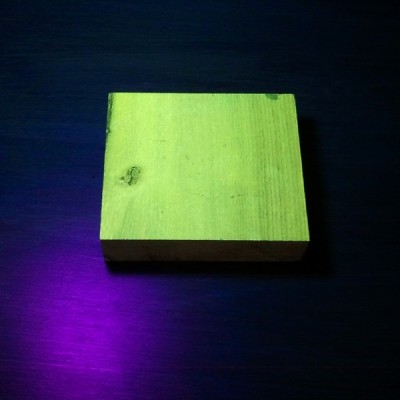
Chemical Testing
There are only a small number of chemical tests regularly used on wood, most of which are very specialized and were developed to help distinguish easily confused species with one another. They work by detecting differences in the composition of heartwood extractives. A chemical substance (called a reagent) is usually dissolved in water and applied to the wood surface: the surface is then observed for any type of chemical reaction (and accompanying color change) that may occur. Two of the most useful are the tests that are meant to separate Red and White Oak, and Red and Hard Maple.
Heartwood Extractives Leachability
Sometimes a wood species will have heartwood extractives that will be readily leachable in water and capable of conspicuously tinting a solution of water a specific color. For instance, the heartwood extractives contained in osage orange (Maclura pomifera) contain a yellowish-brown dye that is soluble in water. (This can sometimes be observed anecdotally when the wood is glued with a water-based adhesive: the glue’s squeeze-out is an unusually vibrant yellow.)
In a simple water extract color test, wood shavings are mixed with water in a vial, test tube, or other suitably small container, and the color of the water is observed after a few minutes. If the heartwood extractives are leachable by water, then a corresponding color change should quickly occur.
In addition to osage orange (Maclura pomifera), merbau (Intsia spp.), and rengas (Gluta spp. and Melanorrhoea spp.) are also noted for their readily leachable heartwood extractives. Because this property is quite uncommon, it can serve to quickly differentiate these woods from other lookalikes.
7. Look at the endgrain.
Perhaps no other technique for accurate identification of wood is as helpful and conclusive as the magnified examination of the endgrain. Frequently, it brings the identification process from a mostly intuitive, unscientific process into a predictable, repeatable, and reliable procedure.
Looking at the endgrain with a magnifier shouldn’t be a mystifying or esoteric art. In many cases, it’s nearly as simple as examining small newsprint under a magnifying glass. There are three components necessary to reap the full benefits contained in the endgrain:
I. A prepared surface.
When working with wood in most capacities, it becomes quickly apparent that endgrain surfaces are not nearly as cooperative or as easily worked as face grain surfaces. However, in this case, it is absolutely critical that a clear and refined endgrain surface is obtained.
For a quick glance of a softwood sample, a very sharp knife or razor blade can be used to take a fresh slice from the endgrain. However, in many denser species, especially in tropical hardwoods, one of the best ways to obtain a clear endgrain view is through diligent sanding. It’s usually best to begin with a relatively smooth saw cut (as from a fine-toothed miter saw blade) and proceed through the grits, starting at around 100, and working up to at least 220 or 320 grit, preferably higher for the cleanest view.
II. The right magnifier.
It need not be expensive, but whatever tool is used to view the endgrain should have adequate magnifying power. In most instances, 10x magnification is ideal, however, anything within the range of 8 to 15x magnification should be suitable for endgrain viewing. (Standard magnifying glasses are typically in the range of 2 to 4x magnification.)
These stronger magnifiers, sometimes called loupes, usually have a smaller viewing area than standard magnifying glasses. Fancier models—with built in lights, or larger viewing surfaces—are available at a premium; but the most basic models are usually only a few dollars.
III. A trained eye.
The third element that constitutes a proper endgrain examination is simply knowing what to look for. In analyzing the patterns, colors, shapes, and spacing of the various anatomical features, there is a veritable storehouse of information within the endgrain—all waiting to be unlocked. Yet, if these elements have not been pointed out and learned, the array of features will simply seem like an unintelligible jumble. The discipline of recognizing anatomical endgrain features is not easily summed up in a few sentences or even a few paragraphs, but it is nonetheless critical to the identification process. To this end, an in-depth look should be given to the various categories, divisions, and elements that constitute endgrain wood identification on the macroscopic level. (In this regard, macroscopic denotes what can be seen with a low-powered, 10x hand lens—without the aid of a microscope—rather than simply what can be seen with the naked eye.) Because the anatomy between softwoods and hardwoods is so divergent, each will be considered and examined separately:Still stumped?
If you have a mysterious piece of wood that you’d like identified, you’ve got a few options for next steps:USDA’s Forest Products Laboratory
You can mail your physical wood samples to the Center for Wood Anatomy Research.
Pros:
- Free
- Professional wood identification
Cons:
- Only available to US citizens
- Slow turnaround times (up to a month or more)
- Limited to three IDs per year
See their Wood ID Factsheet for more info.
Alden Identification Service
You can mail your physical wood samples (even small sections taken from antiques) to Alden Identification Service.
Pros:
- Professional wood identification
- Faster turnaround times (ranging from a few days to a week or two)
Cons:
- Paid service
See their ordering page for more info. (Note that Harry Alden has written several books while at USDA, including both Hardwoods and Softwoods of North America.)
Ask for help online
If the wood ID is merely a curiosity, or non-critical, you can post pictures of the wood in question.
Pros:
- Free
- No need to send physical samples
Cons:
- Greatly limited by the quality of the pictures provided
- Extra work usually required to get adequate clarity in photos
See article of Common US Hardwoods to help find the most commonly used woods.
Get the hard copy
 If you’re interested in getting all that makes The Wood Database unique distilled into a single, real-world resource, there’s the book that’s based on the website—the Amazon.com best-seller, WOOD! Identifying and Using Hundreds of Woods Worldwide. It contains many of the most popular articles found on this website, as well as hundreds of wood profiles—laid out with the same clarity and convenience of the website—packaged in a shop-friendly hardcover book.
If you’re interested in getting all that makes The Wood Database unique distilled into a single, real-world resource, there’s the book that’s based on the website—the Amazon.com best-seller, WOOD! Identifying and Using Hundreds of Woods Worldwide. It contains many of the most popular articles found on this website, as well as hundreds of wood profiles—laid out with the same clarity and convenience of the website—packaged in a shop-friendly hardcover book. 





Why I will no longer be replying to every wood ID request I’ve replied to literally thousands of wood ID requests on this site over the past 13+ years, but as the site’s popularity has grown, so has the time demands for ID on a daily basis. (Contrary to what some may seem to think, I am not some all-knowing wood wizard that can instantly ID your wood. It can actually take me a long time to sift through a lot of different resources.) Over the past few years, my backlog of pending wood species to be added to the… Read more »
Hi Eric, incredibly informative website – thank you for your hard work! I’ve tentatively identified this varnished timber as Horse Chestnut, but would appreciate your opinion please. Its density is about 520 kg/m³. End grain photo attached. I am in the UK
Photos of dresser
Here are photos of the dresser for reference.
Hello everyone! I have this dresser here and I have tried to take the stain off of it by using stripper and some sanding. The stripper was not very successful and left a lot of residue that will not come off with solvent, which is making the sanding difficult. I was wondering if anyone has any suggestions on how to proceed/ if anyone can identify the type of wood it is made out of. Thanks in advance for the help!
Looking at the pictures, I would recommend removing the knobs, and then giving another application of stripper. Also check the directions to see what type of solvent should be used for cleanup. You should have almost no residue left before beginning sanding or the paper will become hopelessly clogged within seconds.
I can’t see the grain close enough to tell wood ID.
Thank you for the helpful recommendations! I have attached more pictures so that you may be able to ID the wood. Thanks again!
Pictures of wood
Pictures of wood
And another! Thanks for the help.
A ring porous hardwood, possibly ash?
Hello Everyone! Would you be able to help with identifying a few pieces of wood I have?
Here is the first pic.
Old growth softwood, not sure on species.
Awesome, thanks. After using the planer on it, it definitely feels like softwood with how easily it came of. Thanks!
Hello everybody. Can anyone help me find oit what type of wood this is? It looks like Zebrawood but not completely sure.
Thank you for your help!
It looks artificial to me. Are you sure it’s real wood? Do you have a larger view of the whole piece?
Good day, have a few bits from some tables that I have recently taken apart, they seemed to have a lot of age, all old wrought iron flathead screws rusted well into the wood.
The 2 large boards are about 800*500 have some decent gravety to them, and have sanded down to glass finish. 1500 grit no dramas.
The leg, no idea…Any suggestions? Thanks!
Hello, very nice website! Would you kindly advise me of what kind of wood and whether this desk is worth buying and refinishing myself, please? I need a desk to study and can not afford anything expensive. I would like to remove the painting spilled on the top of it and possibly stain it in expresso to match my bed color. I had never worked on wood before. Thank you very much for helping!
After looking closer at your pictures, I believe I can see ray fleck on the top grain. It appears to be quartersawn oak, possibly red oak (usually it’s white oak). If it truly is veneer (as I suspect it to be as it looks like two very wide panels on top) it can be tricky to refinish. If I had to approach this, I would use a chemical stripper to remove the old finish, clean it up afterward by wiping it with a solvent, and try to keep any sanding to an absolute minimum. It’s very easy to sand through… Read more »
Hello, I have been in the process of stripping away 10+ layers of paint from the exterior 15 lite door and sidelights of our home. The house is from the 1920s and located in the US (Alabama). My original goal was to simply strip the greatly deteriorated paint away and repaint the door, but I like the look of the wood so I am now considering staining it instead (likely because stripping it has been such a much greater task than originally appreciated that I want a better payoff, but I digress). Before I went further down this path though… Read more »
Looks like southern yellow pine, and given the age of the house, it would be considered old growth wood, so harder and stronger than today’s stuff. Sometimes called antique heart pine.
Hey Eric, I have this turned bowl with a wild grain pattern. Do you have any idea what it might be?
Good Morning,
What a brilliant website! and I also thought your bandsaw bowl idea was fantastic. I have some wood that was from a shipping crate returned from Brazil, complete with an IPCC stamp. I think it may be Ipe or Jatoba…
There is no odor when it is worked nor does it fluoresce under blacklight.
at 11.2%MC it had a density of 712 Kg/cubic Meter
Any thoughts would be greatly appreciated
Thanks, those are some good pictures, especially of the endgrain. Unfortunately, I don’t recognize them as anything that’s commercially common in the US. Definitely not Jatoba or Ipe. The parenchyma is unique in that it forms a net-like pattern along with the rays, something that wood anatomists call “reticulate parenchyma.” So while it may not be easy to say what it IS, it’s usually easy to say what it ISN’T.
OK, thanks Eric.
Hi Eric! It’s my first time here. I hope you may be able to help me identify this danish mcm table and chairs. All pieces are very heavy.
Sorry, I can’t tell. It appears that the table is stained and it’s hard to say what the natural color might be. Also hard to see the wood grain and endgrain.
Purchasing this entryway table today. Planning to do a white wash/ distressed white look. But im wondering what type of wood is it to know which way to go with paint/stain procedures. Eric any input would be gladly appreciated.
Can you get a closer picture of the grain?
Eric, I have one more question. Can you tell me if this chest of drawers is solid wood or veneer? I’ve taken pictures of the back corner, the top and corners/edges of the drawers. Thank you!
I can’t tell for sure from the pictures, it appears too dark, maybe try shining a bright light on the piece, especially that last one of the corner.
Hopefully these pictures are better. Thank you Eric
Thanks, yes it does appear to be solid wood.
Can someone please tell me what kind of wood this chest of drawers is? I purchased it at a garage sale today. It has a few scratches and I’m thinking about refinishing it. Would love to know what kind of wood the drawer fronts and sides are made of. Thanks so much!
The drawer fronts look like cherry.
Please help identify this beautiful piece. It’s extremely heavy and I got it in the U.S.
I have a piece of wood, pretty heavy and dense, definitely unfinished, and visually moderately resembles cocobolo, except it SMELLS LIKE POOP literally. Any ideas? The grain is also a little more liney, more fiberous looking. My woodworking teacher INSISTS that it’s cocobolo, but I’m sure it’s not.
Could you please help identify the type of wood for these floor boards? Ordered already lots of samples but still with no luck no identify correct one :(.
Are you located in North America? It looks most like black cherry to me.
Thank you very much! Yes, I am in South CA. My short list was American Cherry, Maple with cherry finish and oak. The house was built 19 years ago.
Hello, could you please help me to identify what type of wood my front door is made from (based in UK)? Is it natural oak? I’m trying to find a species and tone of hardwood floor that matches the door, but many samples I’ve ordered seem to clash. Any suggestions? Thanks in advance. Ryan
Looking closer I would agree that it is probably oak, although it appears to be a type of red oak rather than the white oak species that are much more common in Europe.
I am from South Africa. We got this planks from a guy, who has no clue what it is. It is a hard wood. The wood was laying a very long time in his shed. Any idea on what it may be?
Hi Eric!
I got some old planks from a friend’s barn that I used to make a farmhouse table. I’ve gotten a lot of opinions on the type of wood it is but I’m not entirely convinced yet. Was hoping maybe you could help! Note: the photos were taken after I coated it with polyurethane. Thanks!
Very hard to make out much details in those pictures, but I *think* I see some ray fleck in the first picture that is strongly reminiscent of oak.
Hi, I’m refinishing a table and chairs. I think this is black walnut but not sure… I need to ID so I can purchase and make a new chair header/top. thoughts?
Forgot to attach the other 2 pics… these are sanded
Looks like walnut to me.
Hi Eric, I’ve been trying to figure the type of wood for weeks out of interest, looking through tons of sample pictures, grains, colors but only managed to narrow it down. My current list includes Maple, Pine or Birch but these might be off completely. Will you be kind enough to help take a quick look? :) thanks in advance. – Singapore
I’d say based on the curl and birdseye in some of the pieces, maple is most likely candidate, but I am thrown off when you say you are from Singapore. It might be something completely obscure (at least from a North American perspective).
Thank you Eric. Yes indeed maple was one of the “lesser suggested” wood types among the people here in Singapore. It’s around 20 years old, so I was looking to get it varnished but really wanted to know a little more about what it’s really made of before doing anything. Thank you though for the help!!
Eric,
I bought some old tools from a guy on facebook marketplace and he tossed in some lumber for me. He told me this was either oak or maple but he wasnt sure. Any idea?
maple
Hello, I have been trying to post a picture both from files and directly taking the picture with my phone but it tells me JPEG are now allowed. I’ve tried to change the format but the post then never goes through. Would someone be able to let me know what format of picture are allowed? I’m hoping to identify the wood type in my 1926 house trim. Thank you!
I don’t know why it says this. JPGs are allowed. Most likely the problem is that they are over 2MB size.
Hi Eric!
I need some more of this crown but I am not sure what kind of wood this is and I couldn’t find anybody around here who could tell me!
Thank you for your help!
Laszlo
Looks like maple with a cherry colored finish
Hi there,
I recently uncovered this beautiful wood hiding under a mahogany finish. Any idea what type of wood it is? Appreciate your help!
Diane
Where are you located? This doesn’t look like a native US species.
San Diego. Got it from an Estate sale.
I know it’s hard to tell, but this was given to me from a roadside construction site piled up on the side of the highway. I got 12 pieces. Any ideas? Thanks.
Eric,
I “inherited” some veneer. I have been able to identify several pieces using your book (Thank You!!). I’ve attached pics of 3 that are figured and I have not been able to identify. Thanks in advance and I appreciate your help.
Bill
Last one (and possibly middle one) could be tamo ash. Not sure on the first one.
Does anyone have an idea on what species this turned bowl could be? I’ve never seen a grain pattern like it before.
Restarting the browser fixed it. I hope this other picture helps. I’m dying for some insight.
It does look pretty unique. Somehow I vaguely remember seeing a pattern like this before, but it escapes my memory. I will try to update this thread if I stumble across it again.
(Also, a piece like that deserves a good thorough sanding and refinishing — it looks pretty rough as-is right now!)
Any idea? Was told it’s an old French door out of Mexico. Thanks love the site.
Pine
looks like pine.
Can you help identify the type of wood for these porch floor boards? It is a covered porch on a 1930s house in NJ. Some of the boards have been replaced over the years but I think this one here is original. I am guessing maybe pine or cedar but I’m not certain. The flooring is painted.
I need to replace some of the boards along the edge that have degraded and I’d like to use the original type of wood if possible. Thanks
Looks like a softwood. Judging by the closeness of the growth rings, I’d say it’s old growth wood that is quartersawn. I think an important detail to try to match would be the quartersawn grain and close growth rings.
Is there a way for me to pin down what specific wood it is?
This is such an incredible resource––Thank you for writing it Eric! I have one question you might be able to quickly help me out with. I’m trying to determine if the exposed wood beams in my loft are capable of supporting a heavy load (such as a chin up bar). I think the wood is clearly stained, but I’m trying to figure out what type of wood it is, if it’s actually particle board (and unable to hold a heavy load), or potentially up for the task. I’ve attached a picture of the beam as well as a close up… Read more »
Michael, the wood looks like regular construction lumber that’s been stained a darker color to blend in with surroundings, so probably something like pine or fir. I think the wood itself should be fine for a chin-up bar.
Hi, is this oak? I want to sand it down and I am wondering what grit sandpaper I should use if it is oak but I am not sure. Thank you!
Oak looks like a strong possibility, yes. Regardless, I would try to use a chemical stripper on it first to get rid of as much finish as possible before sanding.
Def oak.
Can somebody please tell me what this wood is please?
What continent are you located? Also, can you get a closer shot of the grain? I can’t tell from the picture so far.
Can you help me identify this wood?
It is a 3/8”-1/4” veneer on the front door of my 1938 California bungalow.
I stripped >10 coats of paint off of it. I hope to stain it then seal it rather than repaint it.
It has a very fine straight grain.
I hoped to apply and immediately wipe off a dark stain so the grain would be accentuated. Do you think that this wood would do that?
It appears to be an old growth softwood. Based on your location, it could be douglas fir.
As a softwood, it doesn’t have any pores, and I do not think that a dark stain would accentuate the grain at all (the contrast comes from particles of pigment getting lodged in the pores). I would stick to more of an amber or natural colored stain to preserve the grain contrast. As always, test any stain on a small inconspicuous area to see if you’re satisfied with the result before diving in with the whole thing!
Hello Eric thanks for your great book and helpful website! Really appreciate it. I would like to refinish a dresser I got when my mother in law died. I think it could be mahogany? I am not sure but it looks like the drawers might be a veneer over a less expensive wood because you’ll see it’s much lighter on the backside than I would expect if it were solid. I’d like to think it would look beautiful if I stripped it down to its natural appearance. Or is that a painful exercise not worth undertaking in this case? Any… Read more »
The grain does resemble mahogany. The drawer sides at least appear to be made of oak. I think it would really only be a good idea to strip it down and refinished as natural if the drawer fronts and everything is solid wood and not veneer. Would need to see more closeup photos of the edges of some of the drawer fronts and top and determine if it’s solid or veneer.
What is this wood? Found some long posts made of this wood in my barn (80+ years old). I’m in Georgia, if that matters. Wood is darkish brown and grain is pretty tight.
It looks like a softwood based on the grain. I would need to see a clearly sanded pic of the endgrain to get a better idea.
I have inherited this table from my Dad. It was made in 1970 and gifted to my Dad by the carpenter of a Nicaraguan sugar factory, where he was chief engineer.
I have finished it with Danish oil and very happy with the results. Using your site, I think it may be machiche, however, would very much appreciate your opinion.
Please advise if close up pics are required.
Thanks very much in advance,
Boyd
I have a feeling it’s not machiche, the grain looks to varied and colorful. I would definitely need a closeup of the endgrain, ideally taken at the area at the bottom of the “Y” shape.
Hi Eric,
Here’s the end grain as requested.
Thanks
The endgrain seems to rule out machiche as I don’t see much in terms of parenchyma banding. Two possbilities based on size and anatomy are guancaste (fairly lightweight) or monkeypod (medium weight). Could also be a species of Albizia, or something else.
Much appreciated Eric…..
Hi,
I just purchased an old table and I intend sand down the table top and restore it to look new. I am new to these types of projects. The table top apears to be a conglomerate of the same type of wood that was cut in blocks and glued back together. Can you help me identify the type of wood? Also, do you have any restoration tips?
Thank You
It looks somewhat like black walnut, but the pictures are too small/far away to tell enough. Also, the middle picture looks too light, so I’m not sure about what color is correct. Also, if you could get a closeup shot of the endgrain, that would be helpful.
I have this old door I have been refurbishing, but not sure of the wood. Currently looks a little yellow, but that might be from the previous paint now removed… Purchased at a salvage shop in Philadelphia. Thanks!
Looks like pine to me. Possibly eastern white pine.
Thanks Eric! I appreciate this and your book.
Can you, please, identify this wood for a friend in South Africa, it was given to him and we know nothing about its history. Thank you, keep safe.
I’m not very familiar with South African woods, sorry!
not sure were the wood is from. Do you think it is local? not a wood you can take a guess at ?
I have this stump, not sure what kind of wood or tree this is so that I can determine if it would be safe for my pet budgie. Found in texas. Thanks!
I’m “stumped” — sorry!
Hi, I just purchased a house and I’m trying to determine the color of my cabinets. I need to shop online for furniture as I am a first time homeowner and I can’t go to stores due to the severity of COVID in NJ. Help please!
It’s a cherry color.
Any idea what type of wood floor this is? I was thinking maple but not sure.
Looks like hard maple.
Hi, I bought these base mouldings and paid the price for primer pine, but it looks like mdf or fiberboard to me. It also dents very easily. Can you please tell me what you think?
Certainly looks to be a manufactured, man-made product to me.
Hi Eric, can you help me identify these wood floors? I just took off the carpet from my 1908 Craftsman, and uncovered these. Some of it is stained and varnished, while the center of the rooms appears to be unfinished. Much appreciated!
Looks like old growth southern yellow pine, sometimes called antique heart pine.
Hi! We found a bunch of wood in my father in law’s shed, none of us can figure out what it is! Would love your feedback.
Not sure what happened with your pictures, but they have lost a lot of detail. Maybe try a different camera/phone? Also, what continent are you located on? Is the wood average weight, light or heavy? Any scent when being worked?
Hopefully these pictures help.
https://imgur.com/h3KUBVk
https://imgur.com/3dDSBHr
https://imgur.com/JBcn3uE
I am in New England, but we don’t know that the wood is necessarily from around here. The wood is dense and heavy. There is a sweet scent when freshly cut, but fades relatively quickly from the wood itself. It is definitely a hardwood.
Thanks, the endgrain is too rough with saw marks to make out vital details. Is it possible to either sand the surface to a fine grit, or take a very light pass with a miter saw on the end to clean up the saw marks? The devil is in the details in this instance.
Hi everyone, recently moved into a house and it has a wooden step to the garden. Looks like it’s in need of treatment but, not sure what to do for the best as don’t know what wood it is. Can you help identify and maybe how best to preserve please ? Thanks.
Need to post pics.